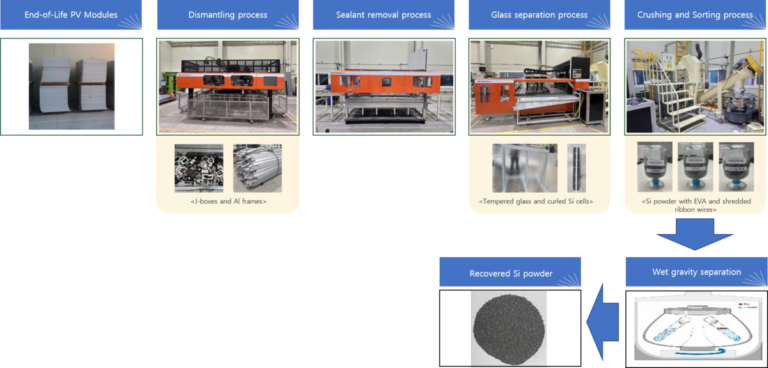Korean researchers have used thermal and wet gravity separation (WGS) to separate EVA from recovered silicon powder in end-of-life PV modules with “minimal” chemical use. The proposed technique produces silicon powder that can be reused as a raw material for upcycling into silicon nitride, silicon oxide or silicon carbide.
Researchers from Gyeongsang National University Jinju in South Korea have developed a new method for separating ethylene vinyl acetate (EVA) encapsulant from recycled silicon energy in end-of-life (EoL) solar panels.
Common mechanical recycling processes involve blending EVA after crushing or grinding, while chemical and delamination methods are generally time-consuming or produce hazardous waste products. The new process uses thermal and wet gravity separation (WGS) to separate EVA from recovered Si powder with “minimum.” chemical use, the researchers said.
The wet gravity separation process uses an aqueous sodium chloride (NaCl) solution that takes advantage of the gravity difference between silicon and EVA, and the WGS process uses the specific gravity of the two materials to facilitate their centrifugation. “All recycling processes were carried out in the commercial facility, except for the wet gravity separation to remove the ethylene vinyl acetate (EVA) encapsulant,” the study’s corresponding author Jongsung Park said. pv magazine.
The whole process starts with disassembling the aluminum frame of the module and removing the sealant. Then a grinding process removes the backing layer and a heating process separates the remaining layers. The next step consists of a shredding process to select EVA encapsulated solar cells, followed by a sorting process based on particle size differences of shredded materials. In addition, powdered solar cells and small particle size metals are separated and a thermal process eliminates the EVA in silicon powder.
“The thermal process at 550 C effectively removed all polymer components, especially EVA, from the recovered silicon powder, as confirmed by various analytical techniques such as TGA, FT-IR, SEM and EDS,” the group explained. “Although effective, the thermal process has notable disadvantages, including high energy consumption and significant carbon dioxide emissions, making it less environmentally friendly than the WGS.”
Further analysis confirmed the effective removal of EVA and other polymers. “The recycling of EoL PV modules was carried out in a commercial facility and an environmentally friendly process was used to recover high-purity silicon,” Park explains. “We have recovered the silicon in powder form and will no longer use it for the production of solar cells, but as a raw material for upcycling into silicon nitride (SiNx), silicon oxide (SiOx) or silicon carbide (SiC).”
The scientists presented the new technique in the study “Development of environmentally friendly pretreatment processes for the recovery of high-purity silicon from photovoltaic modules at the end of their life”, which was recently published in the Royal Society of Chemistry.
This content is copyrighted and may not be reused. If you would like to collaborate with us and reuse some of our content, please contact: editors@pv-magazine.com.


